People to People Student Ambassadors
By Gail Small
Printed in Practical Homeschooling #74, 2007.
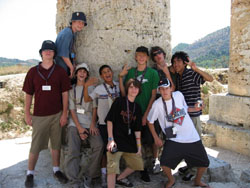 How you can travel to foreign lands, meet important people and everyday folks aronund the world, and get a fabulous item for your transcript.
How you can travel to foreign lands, meet important people and everyday folks aronund the world, and get a fabulous item for your transcript.

|
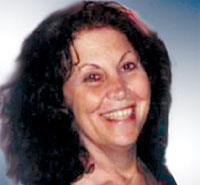 |

"One," "two," "three," "four," "five," rang out the sound of voices raised in pride and excitement. Each number was counted off by one of the 43 student ambassadors gathered for a roll call at Los Angeles International Airport, with passports in hand, wearing shirts labeled with the word "Ambassador." It was a thrill to watch their faces when our flight to Paris was called. Strangers and airport security personnel stopped to look. Tears flowed as parents watched their students begin their dream adventure. Students' tears flowed too with appreciation for the opportunity and the realization that their ambassadorships were suddenly becoming reality.
Surprisingly, these students didn't even know each other nine months ago. But they all had one thing in common. Each was nominated by a teacher, coach, community leader, or another significant adult who acknowledged him or her for academic standing, social skills, awareness, and openness to travel as an American ambassador and to meet people from all walks of life. Nominators recognize students in grades 5-12.
Of my 43 student ambassadors, none were homeschoolers.
Each year I wonder why the amazing homeschoolers I have met have not surfaced in my groups. I know some homeschoolers elsewhere in the country are student ambassadors, yet why not more? I have met and respect so many young, high-caliber homeschoolers who would reap benefits from such an experience. I would like to encourage many more homeschoolers to take advantage of this enriching educational experience. I would also like their parents, teachers, and advisors to be aware of People to People.
What is People to People?
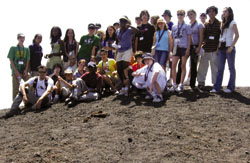
Mt. Vesuvius is grey and rocky, at least on this spot! Other parts are quite green. |
The People to People Student Ambassadors Program (P2P) provides unique learning opportunities that fit beautifully into homeschooling. Participants gain non-stop real-world learning. Family ties are enriched as well: participating students pre-study before the trip and follow up afterwards with further learning. The education is innovative and the materials, which cover every subject, go far beyond any book, movie, Internet course, or class the student may have taken.
Participating students also have the opportunity to receive high school and college credit towards their social science and civics requirements. Those applying for university receive letters of recommendation from People to People stating they have been a People to People Ambassador. Some have told me that they know this has made the difference! (A People to People letter of recommendation has nine United States of America presidents on the letterhead, testifying to the advantages and prominence of being a student ambassador.)
President Dwight D. Eisenhower, America's 34th president and the founder of People to People, stated, "I have long believed, as have many before me, that peaceful relations between nations require mutual respect between individuals." He believed that if "ordinary" people of different parts of the world could communicate with each other, we could solve some of the world differences and find the path to begin to live in peace. Thus, while governments struggle towards achieving world peace, people reaching people could make a difference.

Author Gail Small with student ambassadors, ready to leave LAX |
People to People Ambassador Programs began in 1956 when President Eisenhower called a special White House conference of American leaders. Together, they created the People to People initiative. The vision of People to People has involved firsthand experiences with other cultures and has taken thousands of young Americans across international borders.
Mary Jean Eisenhower, granddaughter of President Eisenhower, now is the President and CEO of P2P International. I have traveled personally with her and observed her first hand dedication to the world and peace. She is a "first lady" with genuine dedication to education and leaders of the future.
In the summer of 2006, for the first time ever, the prestigious Cavaliere per las Pace (Knight of Peace) award was presented to an organization rather than an individual. Mary Jean Eisenhower accepted the esteemed award this summer in Assisi, Italy. Mother Teresa, Mikhail Gorbachev, and Pope John Paul II are previous recipients of the Knight of Peace award, considered one of the most important titles for the curriculum vitae of the Nobel Prize.
I hear that for Mary to sit in the chair where Mother Teresa sat was a tearful and cherished experience. I will be in Assisi with student ambassadors next summer and feel the pride of President Eisenhower's vision of world citizenship in this, the 50th anniversary year of People to People.
It's a Small World
Because my last name is Small, as a young child I thought the Small World attraction at Disneyland was mine. In later years I have discovered that Walt Disney created "It's a Small World" because he participated in the People to People International White House conference. Over 250 million people have discovered the Small World attraction and People to People continues the goal of understanding how all people are alike and different, and that we all share so very much.
 After being nominated and interviewed, I had the privilege of becoming an ambassador and a leader for People to People. In this capacity, I have crossed many borders and boundaries with student leaders who understand, appreciate, and see more than a usual "tour." While like other tour participants they bring home everlasting memories, they also leave a taste of friendship the world over.
After being nominated and interviewed, I had the privilege of becoming an ambassador and a leader for People to People. In this capacity, I have crossed many borders and boundaries with student leaders who understand, appreciate, and see more than a usual "tour." While like other tour participants they bring home everlasting memories, they also leave a taste of friendship the world over.
How It Works
Nominated students first attend an information meeting. They hear from People to People staff about the educational opportunity. They learn that it's an honor to be nominated. Former students come on stage to tell about how People to People was their most valuable learning experience. It's far more than "hands on" because it is real-world learning!
At the completion of every information meeting, the parents are the ones who want to go the most. You hear them saying, "I never got to do anything like this. Even in college, world affairs never came alive. My child has been nominated for a chance of a lifetime."
Once students complete the application and obtain three reference letters, they are interviewed by People to People leaders. Being nominated is in itself an honor and accomplishment. The interview is usually to find if students are truly able to leave home to visit a foreign land and mature enough to reap the benefits of "people to people" interaction.
After the interview, students are assigned to a local delegation. This group meets with carefully selected leaders six times prior to travel so that students are informed, comfortable and learning about worldly things.
Just prior to travel, a Bon Voyage party is held for the delegation of approximately forty students, their families and leaders, always with a ratio of 1 to 10 adults to students. My group, which was traveling to the Mediterranean, had a sweet treat at their party. Each cake was decorated with a flag and scenery of a country on the itinerary: France, Italy, and Malta. At the party, parents have the honor of pinning their child with the official People to People pin, signifying ambassadorship. It's a great photo opportunity! The smiles of all in attendance indicate great pride in the success and accomplishments of these young students.
Paying for the Trip
People to People encourages fund-raising efforts, and what a great feeling this is once accomplished!
The cost of the trip is usually earned by the student. Some speak at Rotary clubs and others read stories for day care or make craft projects for holiday sales. One student might be busy already curb painting and another might be washing dogs in the neighborhood.
People to People provides an entire booklet for student ambassadors entitled "Funding Your Journey: The Keys to Successful Fundraising." It provides students with a clear, step by step process as well as ideas and fundraising suggestions.
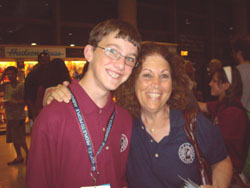
Gail Small with Student Ambassador David Coons |
The booklet's recipe for successful fundraising spells out goals and the long range picture. Suggestions are included for obtaining sponsors and worksheets/flyers are included as well. You can find many additional fundraising resources on the
fundingyoureducation.org site, along with sample letters which are ideal for creating sponsorships.
Community Service
Meeting people is one thing; community service is another. While traveling each year, a special day or two of the journey is set aside for this.
One of my favorite memories is when we went to the market in New Zealand and divided the students into four teams. They were each given the same amount of US dollars. They had to change it into the correct currency and mathematically figure out how to fill their shopping cart with the most items to take to the needy. You could almost see the wheels turning as students figured the exchange rate and how to get the most for the dollar.
This was a true hands-on learning adventure, especially when we tallied the number of items to see who had purchased the most to take to the designated location.
The students' reward was seeing the faces and hearing the words of the people on the stairs sincerely thanking them for their donation and for caring. This is especially meaningful, since many in foreign countries tell us they hear so many bad things in the news about American children and teens.
Meeting Others
Maybe it is the sound of laughter that best defines what People to People is really about.
Splashing flour here there and everywhere with Irish students, we had a cooking lesson to master the art of Irish soda bread. We watched the bread rise and the element of human interaction and understanding rise along with it. Though it rained (stormed) that very day, it became all part of the adventure and the warm delicacy was appreciated even more.
With students in the Australian Outback, we have watched masterful dogs herd the sheep. At one ranch two dogs were in charge. One went over the fence with zest as he ran to circle in the hundreds of sheep. The other, who was handicapped, had to crawl under the fence before he could do his job. Together, they shared their positive and negative strengths while the sheep all came together. A barn dance that evening included Australian students who joined us from many surrounding areas who shared their music, games and dances with us.
Each restaurant and hotel throughout our travels in Australia had a special dinner for Ambassadors. As usual, a banner waved proudly to welcome us upon our arrival. It was another night of hot fudge ice cream sundaes in our honor. (The students knew not to tell anyone that the same honor had been bestowed upon us for a dozen nights prior...)
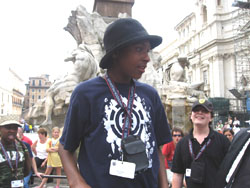
A student ambassador enjoying the architecture in Italy |
One particular hotel had a small stage with a microphone for local talent that performed there over the weekend. The hotel staff announced over the sound system that they felt honored to have student ambassadors and wished us well and world peace for all. To my shocked surprise, one of the students in our delegation ran up to the stage and turned on that microphone. (Please note that he was the shyest one when I interviewed the students for my delegation.) The next thing I knew this student was loudly, clearly, and eloquently singing our national anthem to the entire dining room and hotel. People from the lobby peeked in, people on the stairs came down, and people in the room were speechless. (Especially me!) The commotion and dialogue that followed were another example of what People to People is all about. I later learned that this boy had sung at Dodger Stadium and similar places. We all learned how students overcome shyness (especially among peers) and how this can bring out their very best. He sparked a hotel/restaurant sing-a-long with the visitors and guests from here, there and everywhere joining in.
Once we toured a museum in small groups with English speaking docents. That was all informative and interesting, yet the visit to the museum cafeteria proved the most educational part of the trip. As my delegation entered with their food vouchers in hand to buy any kind of food they craved, they encountered students from a local high school. All were fascinated with each other! With my permission and that of the local teachers and headmaster, the students gathered together in the patio. The adults sat on the top tier of an amphitheatre-type seating, chatting, watching, and enjoying. It was international relations right before our eyes. We relaxed our schedules as it was too good to be true. Two cultures became one and no one wanted to end the meeting. Students exchanged address and years later some still are pen pals who share their thoughts across international borders.
Even when international languages vary from country to country throughout a People to People journey, communicating with those we meet on the way provides more learning than can be found in any textbook. Looking up words and phrases in dictionaries, reading "sign language" and road signs, figuring kilometers, calculating money exchanges, and deciding what time it is at home, are all part of it. Dressing up in our "dress clothes" and finding that others are joining us in kilts is also an eye-opening experience. Student ambassadors find that though we are worlds apart, we are so much the same too.
Now with the age of computers and the Internet, student ambassadors easily become acquainted with fellow nominees from all over the United States. After traveling, communication is kept open with new friends from encounters all over the globe.
Just for Ambassadors
I have guided students to Parliament. New Zealand not only welcomed us, we were escorted into the private chambers and sat at the table of Parliament. How many American students ever get to do this? We were treated as kings and queens. We met Parliament members and history came alive. Because many of the students researched our destinations prior to travel, their text books and schoolwork took on a new reality.
On another trip the year following, in Parliament in England, we met Sir Andrew who explained government and the laws and ways of England. Students listened, shook hands, and journaled so they could write a presentation for school or to bring out one day to share with their own children.
In Tangalooma, by Moreton Island National Park, naturalists came to the island so students could receive one-of-a-kind science studies. For three days we were in natural bush land amid incredible landscaped gardens. We got to actually interact with native wild life. We rinsed our hands so there was no infection and walked deep into the waters. Dolphins stopped by for a snack. Dolphins took fresh fish right out of my hands - not calm, trained dolphins, but two in the wild! I will never forget that moment nor the naturalists' information about nature, the sea, and ecological balance. The next day students saw movies and heard a lecture on pelicans. The next thing we knew we were hand feeding them a few buckets of fish. And if that wasn't enough, after our group discussions and after question and answers geared to young scientists, we went on a boat to be part of the whale migration. Right in front of us, we had a close look at majestic mammals of the sea!
Staying at a castle in the hills of Scotland with I don't know how many rooms (we lost count), one could almost visualize the days of past. A historical lecture enlivened our thoughts, understanding, and imagination. Shepherds' pie and interesting food were tastes to try from books we had read.
I have led students to meet Nessie, the Loch Ness Monster. Sadly, she was not there to personally meet us that day. However, we went on the search boat where we received instruction on how to use the GPS devices and heard the stories and traditions of that part of the land. One boy in our delegation has the name of Urquart and you can imagine his thrill of viewing the Urquart Castle first hand.
This summer Italy was one of the destinations where my delegation traveled. With expression and sincere passion, a guide told us about Pisa... and then we were standing right there.
Walking through the Accademia Gallery, which houses Michelangelo's colossal statute, David, gave us a true glimpse of colorful history. We were told about the 50,000 spectators who once were entertained in Rome, while actually exploring the Forum, Piazza Venezia, and the Colosseum.
Visiting the ancient city of Pompeii, Mount Vesuvius, gave us the feeling of stepping back in history.
Just as we also traveled through France and looked at treasures inside Musee du Louvre, we also spent time in Malta in educational meetings. We also took part in a service project.
Malta is a tiny island nation that has been conquered and inhabited by many different cultures. Balconied buildings were before us, as were narrow streets unfit for traffic. First-hand description by informed educators and locals taught us about stepping back in time.
Each student stood in an example of a walled city which is still inhabited today. They also participated in a treasure hunt which tested their understanding and comprehension.
The Trip Ends
The American flag hanging high in immigration told my students they were home in the U.S.A. With tears of sadness, knowing the experience was about to end, and leaving new friends they have traveled the world with, each student ambassador had his or her outer passport stamped and walked towards the welcoming screams of delight in a crowded airport.
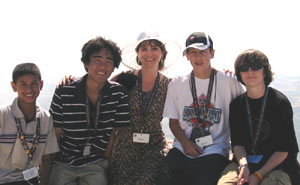
The ambassadors pose with a chaperone while enjoying the sights |
As the People to People student ambassadors emerged from customs, they appeared much different than at the beginning of their journey. As we counted off, "One... two... three... four... five," passers-by now saw a unified group of 43 student ambassadors, wearing their "Ambassador" shirts and with passports in hand, pulling worn luggage that looked like it could tell a story all itself. The vision was exhilarating.
Back in the USA, "Welcome Home" banners, smiles, tears, and emotion prevailed. It wasn't an end, though... it was the beginning of more steps toward each student's tomorrows and the world's future.
I wouldn't miss this for the world!
What Makes P2P Unique?
P2P differs from other student opportunities because students are representing their country as ambassadors and encountering "people to people" experiences every day while on their journey. There is a feeling of community and each encounter has been planned down to the smallest detail for a treasured learning experience. Walking into Parliament, meeting and speaking to a Town Council, speaking, singing, and sharing with international leaders is something that stays with you the rest of your life. Leadership develops as student ambassadors share rolls, tea, or escargot with locals and discuss likes and differences throughout the world.
Students are led by educators who have been nominated for their dedication to learning and to embracing new experiences.
Student ambassadors become more aware of the world around us while proudly representing the United States of America. They become "citizens of the world."
As a teacher for 35 years, I have seen the many phases of learning and instruction. I have watched the era of "lesson plans" evolve into newer modes of parent participation and hands-on learning. But nothing I have encountered even begins to compare to the challenges and learning that People to People dedicates themselves to for young student ambassadors.
If American public school students can participate and become intellectually enriched, then more homeschoolers should, too.
You can go to peopletopeople.com for a peek at the vast opportunities. It's easy to learn how to nominate your student. You can use my contact information (GailSmall.com) to connect with me to ask questions and to find out more.
A quote from President John F. Kennedy says what I truly feel: "The nature of People to People activities is as varied as the individuals involved. The housewife whose recipe contains the yeast of kindness, the soldier whose arms embrace homeless waifs, the doctor who heals with humility, all assert a single theme - the power of people, acting as individuals, to respond imaginatively to the world's need for peace."
I hope that more homeschoolers will now take advantage of the opportunity to travel the globe with People to People Student Ambassadors and enjoy this vast variety of educational and cultural experiences.